Guest review by John Hall.
Let’s face it – if you’re reading this blog you have known since your age could be measured in single digits that Triceratops was a late Cretaceous ceratopsian from North America whose name means “three horned face”… etc., etc., etc. So how can I open this review of yet another Triceratops model with some sort of novel perspective on this famous dinosaur? Well, one thing we perhaps tend to forget about Triceratops is that this wasn’t just a ceratopsian, but a giant ceratopsian. Forget the traditional comparisons with rhinos – at 9 tonnes and 8 metres long, these bad boys were considerably bigger than elephants (a very large African elephant bull can reach a little over 6 tonnes and stand 4 metres tall at the shoulder). Triceratops was also more or less double the size of other familiar ceratopsians such as Styracosaurus and Chasmosaurus. Considering this size, to witness those incredible horns in action (perhaps as either an offensive weapon against predators, or as a means to settle disputes between rival males) must have been a truly staggering sight. Since African elephants today are quite capable of knocking down entire trees to browse their foliage, the impact of Triceratops herds on the local plant life must also have been quite appalling (I’m a botanist – I like to think of these things, even if no-one else does).
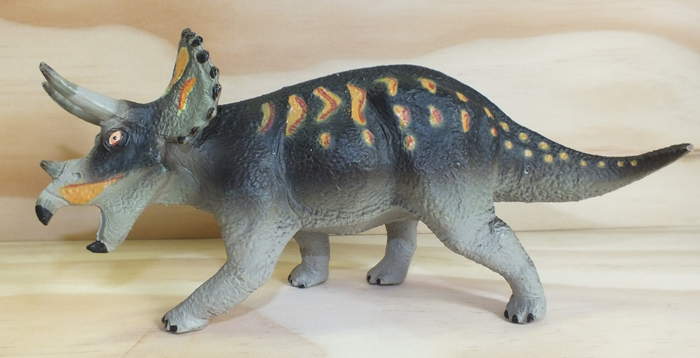 

The figure I am reviewing today is the version of Triceratops released by Safari Ltd as part of the Carnegie Collection in 1999. Somewhat confusingly, there are two Carnegie versions of Triceratops, both of which are still being produced by the Safari company. The original Carnegie Triceratops was released in 1988, although it has had numerous changes in colour scheme since then (you can find an excellent review of this figure by Griffin here). As you might expect, the later, 1999 figure has a considerably more dynamic pose, although it could hardly be called a replacement for the original figure, since both are still being made and sold today.

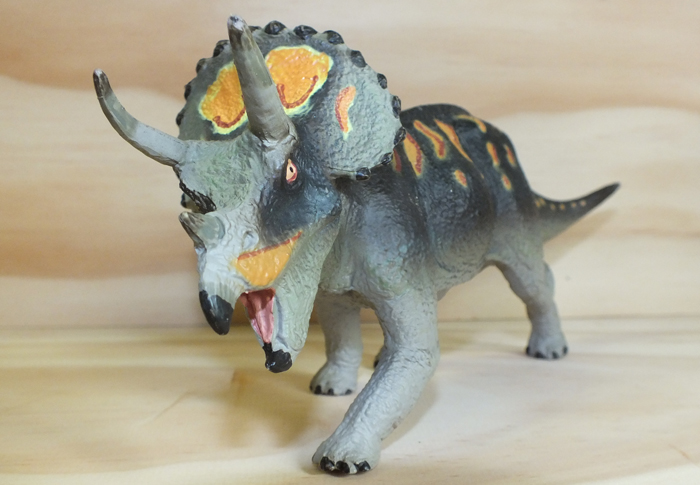 

It seems to me that dinosaur figures of this kind need to be reviewed as both children’s toys and display pieces for collectors, and to begin with the positives, there is no doubt that this Triceratops is an excellent toy. The posing of the legs is very appealing, as if the animal was captured in the moment of lunging forward. This is complemented by the very striking expression on the face, with the eyes wide and the beak agape, as if roaring in fury at some unseen foe – a cliché indeed for theropod models, but to see such a moment of aggression captured in a “placid” herbivore is quite refreshing, and certainly in keeping with the awesome weaponry possessed by this animal. The colour scheme is very well conceived, with flame-like orange stripes along the charcoal black flanks. Especially welcome (given the fact that the head is the focal point of every Triceratops model) is the fact that the face shield is similarly adorned with orange, red and yellow markings. Whatever colour these animals were in life, it seems a safe bet that ceratopsian head shields were display structures of some kind and it is hence almost inconceivable that they didn’t bear bright colours and patterns in this way. Ceratopsian models always look distinctly unrealistic to my eye without them. The Safari Ltd website gives the dimensions of the model as 18.5 x 9 cm. Curiously, different Safari Ltd literature I have seen lists the scale of this model as both 1:35 and 1:45; but I suppose the traditional Carnegie scale of 1:40 can be safely assumed.
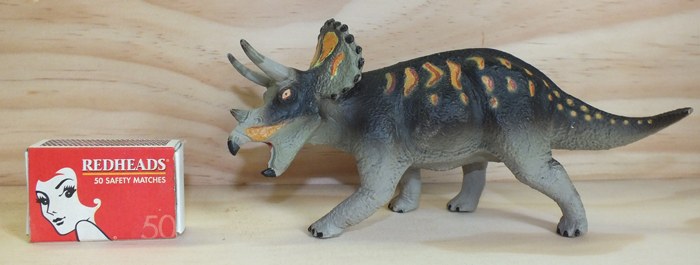 

While I would hazard a guess that kids playing with dinosaurs will love the intense expression on this fellow, I must say that as a collector I find this model a little disappointing. One thing that detracts from the dynamic pose is that both head and tail are turned in the same direction to form a U-shape. This means the model can only be displayed to good effect from one side; I personally find head and tail curving in opposite directions (in an S-shape curve) to be much more aesthetically pleasing and versatile in terms of display. The very exaggerated angle of the jaw gape also seems rather disconcerting. I’m no anatomist, but I find it hard to believe a Triceratops would be able to drop its lower jaw to such a degree; I can’t help but be reminded of a rattlesnake or moray ell rather than a huge plant-eater. Speaking of the head, this sculpt gives the facial features a very fleshless, sunken look, especially along the lower jaw and below the eyes, reminiscent of the ghastly “zombie dinosaur” restorations briefly in vogue during the seventies. The tail seems very stubby to me, although I concede that short-tailed ceratopsians are entirely consistent with modern skeletal restorations. Still, given the fact we can’t really know how much length was added to the tail by flesh and muscle, it seems to me that a little extra tail length for aesthetic reasons is fairly justifiable. The pebbly skin is pleasing enough in concept, but at least on my example the texture was disappointingly shallow and lacked crispness. The execution of the painting on mine was also pretty crude, with the brush marks of the red detailing rather poorly done – but again, I’ll give the benefit of the doubt here and suggest this may be an unlucky quirk of my particular model.

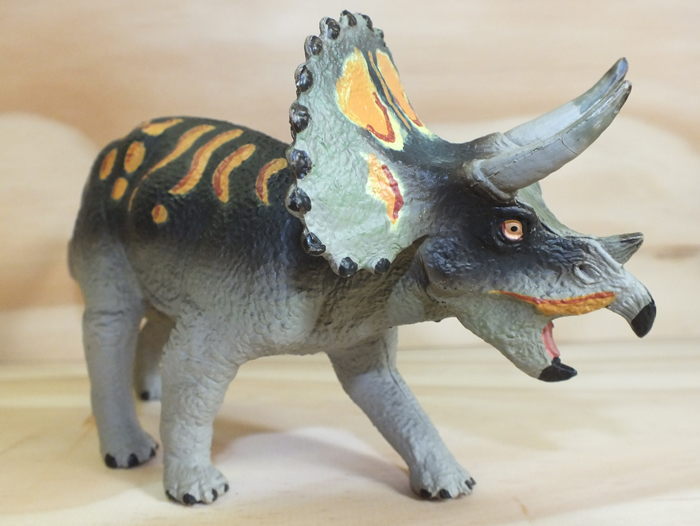 

Overall, I would say that this is one of those dinosaur figures that unfortunately photographs considerably better than it looks when you hold it in your hands (I’m rather surprised by how cool this model looks in my own photos, despite my negative comments above!). The dynamic posing is a definite improvement on the original Carnegie Triceratops, but since this was a pretty forgettable three-horned-face anyway, this isn’t really saying much. Ceratopsian collectors will want this figure, as will anyone hunting a complete set of the Carnegies; but it seems to me that for anyone who is just looking for a handsome 1:40 triceratops for display purposes, the collectA trike is probably the better option.
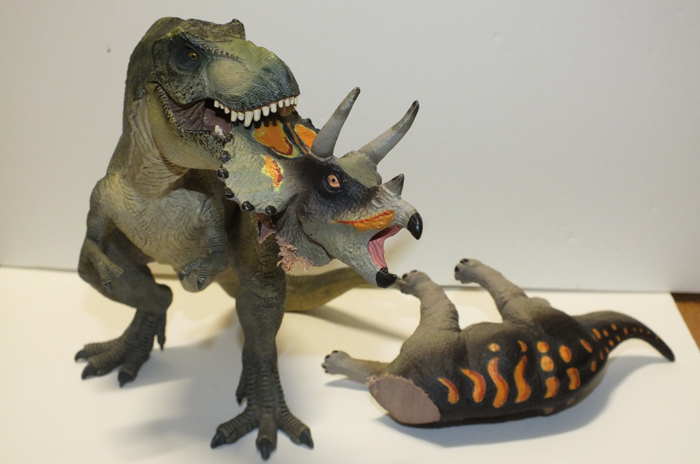 


Unfortunately, as graphically illustrated above, the museum-endorsed status of the Carnegie Triceratops still gives it little protection again “less-realistic” models with considerably more ‘tude. Don’t panic folks! I’m not a member of some weird cult that sacrifices lesser dinosaur models to the Papo Tyrannosaurus – (cool though that would be). I have just sawn the trike’s head off prior to remodelling the head position.
—
This figure is available from Safari Ltd here, Amazon.com here, and Ebay.com here.
Disclaimer: links to Ebay and Amazon on the DinoToyBlog are affiliate links, so we make a small commission if you use them. Thanks for supporting us!




[…] and the tail is bent slightly to its right. The detail on this toy is not as good as version 1 or 2 of the Carnegie’s, and falls well short of its Wild Safari replacement. The model does have […]
Great first review! Like Scott I also prefer the WS Triceratops. I have no real desire to own this Carnegie model but I do like the color choices.
Excelente el artículo y realista. Aunque mejora con creces la versión anterior de Carnegie desde mi humilde punto de vista merecería que se hiciese una mejor versión.
Me gusta más el Triceratops de Safari es más realista
I actually like the Wild Safari Triceratops quite a bit more than this one. Sometimes the Carnegie models really hit it out of the park. But in the case of the Triceratops (and Stegosaurus), the Wild Safari versions seem preferable. In any case, nice review!